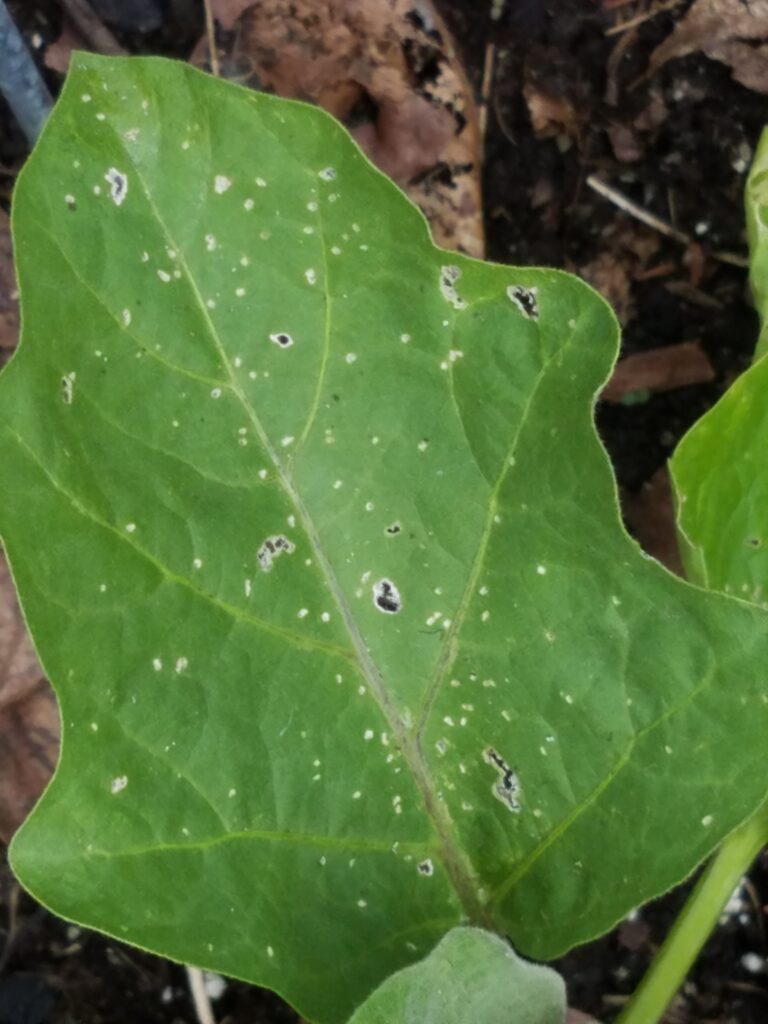General

The flea beetle is a type of leaf beetle that can be found anywhere and on many different plants – vegetable crops; shrubs; weeds. Some species of these little beetles do good by eating invasive weeds while many of their relatives are known garden pests that can exact extensive damage to plants including radishes, broccoli, cabbage, turnips, eggplant, peppers, tomatoes, potatoes, spinach and melons to name a few.
Common types of Flea Beetles:
Crucifer flea beetle; crucifer flea beetle; striped flea beetle; western black flea beetle; potato flea beetle; spinach flea beetle
Description
Most adult flea beetles are small, 1/16 –1/8th inch long. An exception is the spinach flea beetle, which is 1/4-inch long.
Since there are different species, flea beetles come in different colors such as: black, bronze, bluish or brown to metallic gray. Some even have stripes. They all have large back legs which they use for jumping (something like fleas) – this can make for easy identification.
Their eggs are very small and are white. They are laid in the soil. Unless you are trained and have a strong magnifying glass, don’t bother looking for any.
Larvae are small white grubs. They will be down at the root level. Again, unless you are trained and have a strong magnifying glass, don’t bother looking for any.
Territory/Habitat
Based on the many species of this bug, they are found worldwide.
Diet
Plants, leaves, stems, fruit and the larvae of certain species are known to eat roots. These can be bad garden or crop pests. For gardeners, eggplant, corn, and cabbage family crops (i.e. cabbage, broccoli, and cauliflower) are very susceptible. There are flea beetles that attack tomato, potato, pepper, beet, spinach, turnip, radish, plus almost every other vegetable to some degree.
Signs of Damage
Flea beetles chew irregular holes in the leaves that can look like small, scattered pellet shot. Severe flea beetle damage can result in wilted or stunted plants. They can attack and destroy seedlings. I have had eggplant seedlings so severely impacted that the harvest was basically nil. When damage is bad enough crop production will be adversely affected.
Life Cycle
Flea beetles live through the winter as adults in leaf litter or other protected cover. They become active in early spring. Depending on the species, females lay single or clusters of eggs in small holes, in roots, soil or leaves of many vegetables as well as occasionally on flowers and ornamental shrubs and trees.
Small white larvae hatch from eggs and feed on the roots. Larvae then transform into pupae in the ground. There are usually one to two generations per year.
Treatment
Flea beetles are best managed through a combination of methods. Since they are most damaging in spring, you will need to monitor for leaf damage. If there is damage – treat immediately!!
When closing up your garden for winter you can remove old crop debris or till it into the soil so that beetles will not be able to get protection in the winter.
First step during growing season is if you think you have flea beetles and damage indicates flea beetles, try yellow sticky traps you can place in your garden to catch some.
Use row covers to keep beetles out while seedlings are growing. As the plants mature, remove the row covers before the flowers bloom.
Some advice is to plant a favorite crop, such as radish, as a “trap crop” so you can draw in the beetles and treat. I personally don’t do that. The way I see it is all you are doing in ringing a dinner-bell for the bugs.
Microctonus vittatae, a native braconid wasp, and tachinid flies kill the adult flea beetle. The larvae of this wasp develop on the female flea beetle and prevent the beetle from reproducing. To encourage these insects, plant flowers such as caraway, herb fennel and coriander as well as flowers such as poppies, marigolds and yarrow.
To control the larvae try using parasitic nematodes in your garden beds. Install them in beds just before planting crops. If the larvae can be controlled or killed, you can almost eliminate local populations.
You can also dust plants and surrounding soil with diatomaceous earth.
There are many pesticides labeled for treating flea beetles. Check with your nursery to put together a program
Notes of Interest
Other flea beetle species are beneficial, feeding on weeds and similar nuisance plants. A few species have even been introduced to various locations as biological control agents against some weeds. One important example is in the control of Leafy Spurge (Euphorbia esula), an invasive weed in the United States. It has a toxic latex and is generally avoided by herbivores. Flea beetles of the genus Aphthona have been successfully introduced to control this plant.